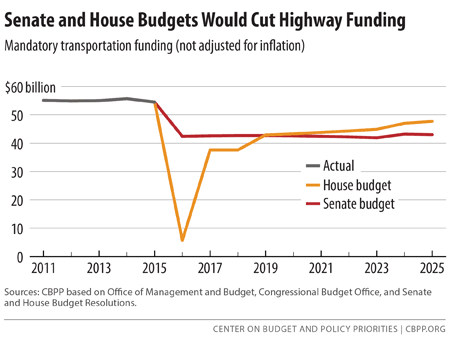BEYOND THE NUMBERS
Now that the House and Senate have both passed their budget plans, here’s one more problem with them: they’d cut highway construction and other transportation infrastructure funding over the next decade by 28 percent and 22 percent, respectively, below the cost of maintaining current funding levels. Although the plans cite the Highway Trust Fund shortfall to justify these cuts, cutting investments in highways and mass transit isn’t the right solution.
The House budget calls for cutting mandatory funding in the transportation section of the budget by almost 90 percent in 2016, from $54 billion to $6 billion, as the chart below shows. It then allows only a partial restoration, holding funding well below the 2015 level through the middle of the next decade. The total ten-year cut is $154 billion (28 percent) below the cost of continuing current funding.
The Senate budget cuts funding far less steeply in 2016, from $54 billion to $42 billion; its ten-year cut is $123 billion or 22 percent.
Virtually all of these cuts appear to come from highway and mass transit programs financed through the Highway Trust Fund. The House and Senate Budget Committees cite trust fund shortfalls as the reason for the cuts, but these shortfalls are neither new nor unexpected. Since 2008, dedicated revenues in the trust fund — mostly from taxes on gasoline and diesel fuel — haven’t been sufficient to cover the authorized and ongoing costs of federal highway and transit programs. One reason is that the taxes aren’t indexed for inflation and policymakers haven’t raised them since 1993. (The gas tax is 18.3 cents per gallon.) Also, revenues have slowed due to major fuel economy improvements and some decreases in driving.
To alleviate the shortfall, Congress has supplemented motor fuel tax revenues through various temporary measures, the latest of which will soon run out. The House and Senate budgets offer a different solution: to cut infrastructure spending to bring it into line with revenues from motor fuel taxes. The House version does so suddenly and dramatically, apparently by almost shutting off new contract authority (that is, the authority for states and other entities to sign contracts for highway and mass transit projects involving federal funds) in order to bring spending down quickly. The Senate takes a more gradual approach.
Both plans, however, will result in significantly smaller highway and transit programs at a time when many urge more investment in infrastructure in order to reduce congestion, increase capacity, and improve the performance and safety of our nation’s highways, bridges, and transit systems.

